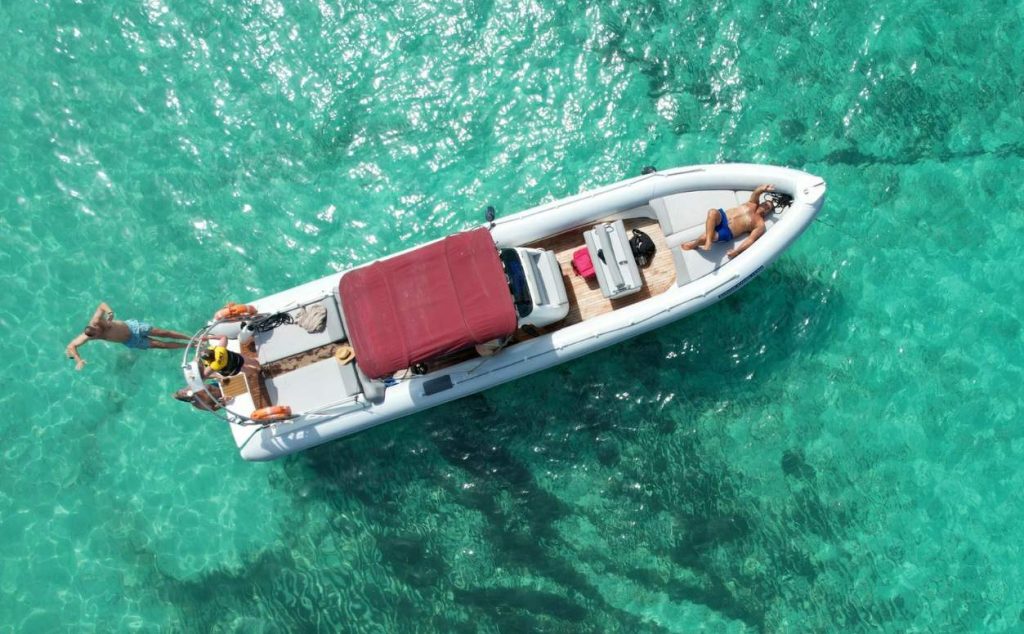Why to Rent a RIB to Explore Crete & the Greek Islands

Updated: December 06, 2024
By PANOS BARDIS, Owner & Ceo of SEAZE THE DAY
Greece has always been a place with a deep connection to the sea. Many of its famous heroes and tales, like Odysseus from Homer’s “Odyssey”, are tied to maritime adventures. Mythology and history are filled with stories of the sea.
Greece is home to over 6,000 islands, with about 227 of them inhabited. Most of its mainland is also surrounded by sea. It’s no wonder Greece is known for its nautical history and traditions.
Greece is also famous for its blue waters, sunny summers, and stunning beaches. What better way to explore this beautiful country than by boat?
But what type of boat is ideal? The answer is simple: RIBs (Rigid Inflatable Boats). These boats are not just popular with tourists. They are also the top choice for locals.
In this blog, we’ll explain why RIBs are the ultimate way to explore Crete and the Greek Islands. Get ready to dive into the details of this exciting adventure!
What is a RIB Boat?
A RIB boat, short for Rigid Inflatable Boat, is a type of motorboat known for its stability, speed, and versatility.
While many people call them “RIB boats,” the correct term is simply RIB, as the name already describes its design.
RIBs combine a rigid hull with inflatable tubes (called sponsons) along the sides. This innovative design makes them lightweight, highly buoyant, and safe in all water conditions.

The History of RIBs
The story of Rigid Inflatable Boats (RIBs) begins in the 1930s, with the invention of early inflatable boats by Pierre Debroutelle, an engineer for the French Naval Air Force. Working under the Zodiac brand, Debroutelle designed lightweight, buoyant boats for rescue operations and military transport. These fully inflatable boats were a game-changer for their practicality and ease of use.
However, it wasn’t until the 1960s that the concept of the Rigid Inflatable Boat (RIB) emerged as a major innovation. At this time, a team at Atlantic College in Wales developed the first RIBs by combining a solid polyester hull with inflatable sponsons (sides). This design offered unmatched stability, speed, and safety, making RIBs ideal for use in rough seas and extreme conditions.
As a result, manufacturers like Zodiac and Avon quickly embraced the new design. Soon, RIBs became essential tools for militaries and coast guards worldwide, excelling in search and rescue missions, patrols, and challenging maritime operations.
By the 1980s, RIBs transitioned into the recreational boating market, gaining popularity for their versatility and reliability. They became a favorite for many activities, ranging from fishing and diving to luxury tenders and coastal exploration.
Today, RIBs are celebrated as one of the most innovative and practical boats, blending safety, performance, and versatility to meet the needs of professionals and adventurers alike. Whether used for work or leisure, RIBs continue to prove their worth on the water.

What Makes RIB Boats So Special
RIB boats, or Rigid Inflatable Boats, are celebrated for their unique combination of lightweight design, performance, and versatility. Whether you’re cruising open waters or navigating hidden coves, RIBs offer a host of advantages that make them stand out.
Lightweight and Fuel-Efficient
RIBs are built with inflatable air tubes and a rigid hull, making them significantly lighter than traditional motorboats. This design allows for greater speed and fuel efficiency, reducing costs and environmental impact. Their lightweight construction also makes them easier to handle on and off the water.
Smooth and Stable Ride
The inflatable air tubes on a RIB provide exceptional stability, even in rough waters. This results in a smooth ride with minimal rocking, offering comfort for families, first-time boaters, or anyone prone to seasickness.
High Performance and Maneuverability
RIBs excel in speed and agility, making them perfect for reaching places that other boats can’t. Their maneuverability allows them to navigate shallow waters, tight coves, and secluded spots with ease, ensuring a memorable exploration experience.
Versatile and Adaptable
RIBs are incredibly versatile, making them suitable for a wide range of uses. From fishing and diving to luxury cruising and adventure tours, RIBs adapt effortlessly to meet your needs. Whether for recreational outings or professional use, they perform exceptionally in every scenario.
Stylish and Adventurous
With their sleek and modern design, RIBs bring together style and functionality. They offer a perfect balance between a rugged, adventurous spirit and luxurious, comfortable features, making them an appealing choice for any type of outing.
Easy to Launch and Retrieve
Launching and retrieving a RIB is straightforward and requires no special equipment or heavy-duty vehicles. Most RIBs are designed to be lightweight and easy to handle, making them accessible for both experienced boaters and beginners.
Accessible and Convenient
Getting in and out of a RIB is simple, whether from a dock or in shallow water. This feature is particularly valuable for activities like swimming and snorkeling, where ease of access adds to the overall experience.
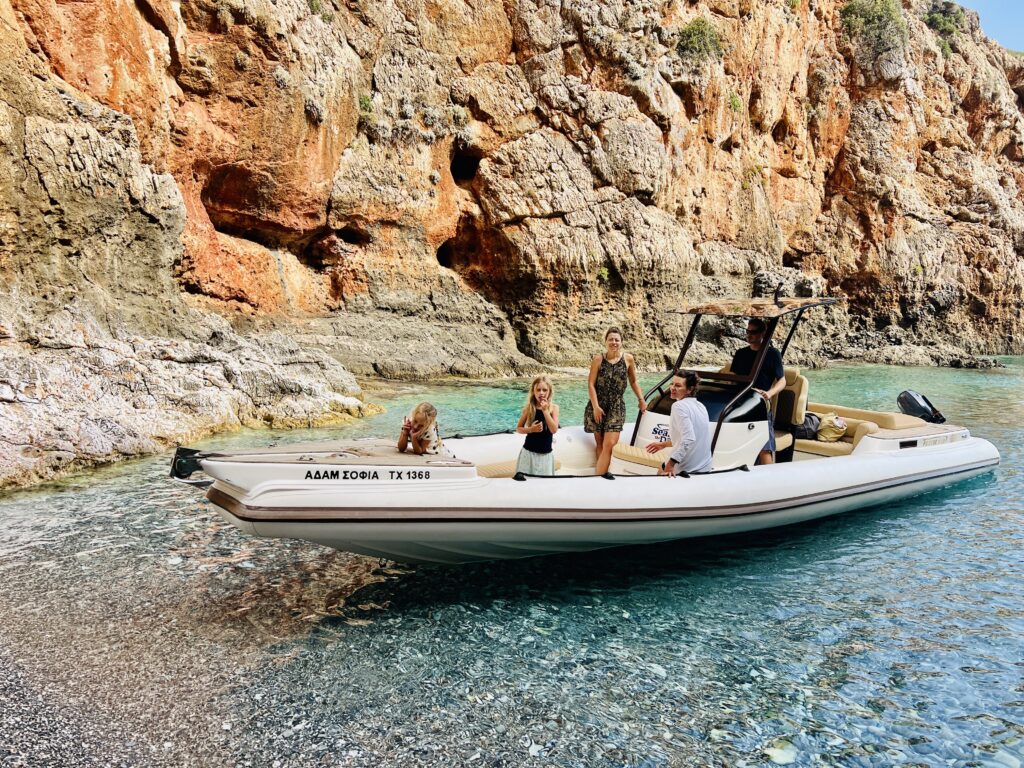
Exploring the Different Types of RIBs
RIBs by Size: Small, Medium, and Large
Small RIBs (3.6–5.5m): Compact and Convenient
Small RIBs range from 3.6 to 5.5 meters, accommodating 2–4 persons. They often feature inflatable designs without polyester hulls, making them lightweight and easy to transport without a trailer. These RIBs are ideal as tenders for yachts and sailing boats, offering quick mobility in harbors or marinas.
For those in need of a practical, portable option, RIBs in the 4.5–5.5m range are popular among commercial fishermen, spearfishers, and vacationers. These boats are perfect for shorter routes and easy handling, providing an efficient and versatile solution for those who want a reliable boat on the go.
Medium-Sized RIBs (6–8.5m): Versatile for Day Trips
Medium RIBs, measuring 6 to 8.5 meters, are the most common size due to their flexibility and practicality. These open-deck boats are ideal for up to six passengers, making them perfect for a wide range of uses, from fishing and diving to coastal exploration.
Their balance of size and maneuverability allows them to handle longer routes while still being easy to manage, providing a great option for those seeking versatility in their boating adventures.

Large RIBs (9–11m): All-Weather Performance and Versatility
Large RIBs, measuring 9 to 11 meters, are built for performance and endurance, making them the ideal choice for various occasions. Known for their excellent stability and reliability in all weather conditions, these boats are perfect for long-distance trips, offering comfort and safety even when venturing far offshore.
With spacious decks and seating, these RIBs can comfortably accommodate up to 8–9 passengers, making them a fantastic option for island hopping or exploring multiple destinations in a single day. Their large fuel tanks allow for extended cruising without frequent refueling, making them well-suited for journeys that require covering significant distances.
This size of RIB is also a favorite as a chase boat tender for larger yachts, providing quick transport for guests and supplies while complementing the luxury experience of yacht ownership. Whether for leisure, exploration, or support roles, large RIBs offer unmatched versatility and capability.

Mega RIBs (12–16m+): The Yacht-Class RIBs
Mega RIBs are the pinnacle of luxury, power, and style in the Rigid Inflatable Boat world. Ranging from 12 to 16+ meters, these high-end vessels are often equipped with cabins, WCs, shaded lounges, and large sunbathing areas. Built for VIP charters, island-hopping, and yacht chase boats, they offer a next-level experience.
With twin, triple, or even quad engines, Mega RIBs can achieve high speeds and long-range cruising. Their large fuel tanks support multi-day trips without refueling, making them ideal for long-distance adventures.
Leading brands like Technohull, Ribco, Skipper, Scorpion, Cobra, Anvera, Motonautica, Salpa, and Rafnar have set new standards in design and performance. These premium vessels combine elegance, comfort, and speed, making them the ultimate choice for luxury cruises and exclusive charters around Crete and the Greek islands.

RIB Configurations: Open Deck vs. Cabin
When Rigid Inflatable Boats (RIBs) first entered the market, they all featured an open deck design. This style was practical, lightweight, and perfectly suited for the boat’s original purpose as a rescue and patrol vessel. However, as RIBs became more popular for leisure and recreational use, especially as larger models entered the market, the cabin RIB configuration began to emerge. These two styles offer distinct advantages and serve different boating needs.
Open Deck RIBs: Freedom, Space & Adventure
Open deck RIBs are the original and most iconic design. These boats are known for their simplicity, versatility, and the sense of freedom they offer. As an experienced owner of open deck RIBs, I can confidently say that they provide one of the most immersive boating experiences.
Key Features of Open Deck RIBs:
- 360-Degree View: One of the biggest advantages of an open deck RIB is the unobstructed panoramic view. You feel more connected to the sea, like riding the waves on a surfboard. This open experience makes exploring coastlines and navigating crystal-clear waters unforgettable.
- Spacious Layout: Open decks provide more room for passengers, sunbathing, and free movement on board. They also make it easier for people to get in and out of the boat, especially for swimming or snorkeling.
- Increased Passenger Capacity: Due to the absence of enclosed structures, open deck RIBs often have more seating capacity than cabin RIBs of the same size. This makes them ideal for day trips with larger groups.
- Lightweight & Agile: Without the added weight of a cabin, open deck RIBs are lighter, which contributes to faster speeds and better fuel economy. This makes them ideal for quick trips and short-distance cruising.
- Accessibility: The open layout provides easier access for boarding and disembarking, especially for children, elderly passengers, or those with limited mobility.
Perfect For:
- Day Trips & Coastal Exploration
- Snorkeling, Diving & Swimming Stops
- Groups of Friends & Large Families
- Those Who Value Scenic Views & Freedom
While open deck RIBs are fantastic for day trips and leisure cruises, they lack certain comforts and privacy. This is where cabin RIBs come into play.

Cabin RIBs: Comfort, Privacy & Longer Journeys
As the demand for RIBs grew, especially for longer journeys and multi-day island hopping, the industry introduced cabin-style RIBs. These boats cater to those who seek comfort, protection from the elements, and the option to sleep onboard.
Key Features of Cabin RIBs:
- Onboard Shelter & Protection: The most notable feature of cabin RIBs is the inclusion of an enclosed cabin. This space provides protection from the weather (rain, wind, and sun) and offers a place to relax, nap, or sleep during long trips.
- Sleeping Space & Beds: Cabin RIBs often have a small cabin with bunk beds or a convertible seating area, which allows passengers to rest during long-distance trips. Families with young children and infants particularly appreciate this feature.
- Onboard Toilet (WC): Most cabin RIBs have a marine toilet (WC), which is a key advantage, especially for families with children. This offers more privacy and comfort compared to open deck models, which generally don’t have a toilet onboard.
- Storage Space for Luggage: Island hopping often requires carrying luggage or bags, and cabin RIBs provide dedicated storage compartments. These can store everything from personal items to snorkeling gear, food, and drinks.
- Privacy & Security: With a lockable cabin, guests have a place to store personal items safely, which is especially useful during long multi-stop trips.
- Extra Weight & Fuel Consumption: Cabin RIBs tend to be heavier than open deck RIBs due to the added materials for the enclosed structure. This results in slightly reduced fuel economy, but it’s a small price to pay for the additional amenities.
Perfect For:
- Multi-Day Island Hopping
- Families with Young Children (or Babies)
- Travelers Seeking Overnight Stay Options
- Long-Distance Cruising & Adventure Trips

Engine Types: Outboard vs. Inboard
Choosing the right engine for your RIB (Rigid Inflatable Boat) can make a big difference in performance, comfort, and maintenance. Early RIBs typically had outboard engines, but as RIBs grew larger and more versatile, inboard engines became popular for larger, more luxurious models. Here’s a quick guide to help you understand the pros and cons of each.
What is an Outboard Engine?
An outboard engine is a self-contained engine mounted at the back (transom) of the boat. It includes the motor, gearbox, and propeller all in one unit. Outboards are most common on small to medium-sized RIBs (3-9m).
Why Choose an Outboard Engine?
- Lightweight & Fast: Outboards are lighter, which gives better speed and quick “planing” (when the boat lifts onto the surface of the water).
- More Storage Space: Since the engine is outside the boat, you get more space inside for passengers, luggage, or equipment.
- Easy Maintenance: Outboard engines are simple to maintain, repair, and replace compared to inboards.
- Better Accessibility: Because it’s on the back of the boat, it’s easier to access for repairs or upgrades.
Drawbacks of Outboard Engines
- Noisier Ride: Since they are exposed, outboards are generally louder than inboards.
- Less Torque: They offer less torque, meaning they need more power to “plane” (when the boat rises on the water’s surface).
- More Exposure: Outboards are exposed to saltwater, weather, and corrosion, but proper care can reduce this risk.

What is an Inboard Engine?
An inboard engine is installed inside the hull of the boat. It’s similar to a car engine, driving a propeller through a shaft under the boat. Inboard engines are often used on larger RIBs (9m+) or luxury RIBs for stability, smooth cruising, and long trips.
Why Choose an Inboard Engine?
- More Stability & Balance: The engine sits inside the hull, offering better weight distribution and more balance, especially in rough seas.
- Quieter Ride: Since the engine is under the deck, you’ll enjoy a more peaceful, quiet cruise.
- More Torque: Inboards have higher torque, meaning they can lift the boat onto a plane with less effort.
- Fuel Efficiency: Diesel inboards are fuel-efficient, ideal for long trips or island hopping.
Drawbacks of Inboard Engines
- Complex Maintenance: Maintenance requires removing panels or decks to access the engine, which can be costly and time-consuming.
- Takes Up Interior Space: The engine takes up room in the hull, leaving less space for luggage or passengers.
- More Expensive: Inboard engines are more expensive to buy, install, and repair compared to outboards.

Engine Setup: Single vs. Twin
Choosing between a single engine or twin engine setup for your RIB (Rigid Inflatable Boat) depends on your needs, the size of the boat, and the type of trips you plan to make. Each setup has its advantages and disadvantages, so it’s important to understand which option best suits your boating style.
Single Engine: Simplicity, Efficiency & Essential Backup
A single engine setup is common on smaller RIBs (typically up to 8 meters) and is often preferred for its simplicity, affordability, and efficiency. However, for safety reasons, it is highly recommended to have an auxiliary engine as a backup in case the main engine fails. This ensures you can always return safely to shore.
Why Choose a Single Engine?
- Lightweight & Balanced Design: With only one engine, the boat has less weight at the stern (back of the boat), improving handling, balance, and overall stability.
- Fuel Efficiency: Single-engine boats consume significantly less fuel compared to twin-engine setups, making them more affordable for frequent trips.
- Easier to Maintain: With one engine instead of two, there are fewer parts to maintain, repair, or replace. This means lower costs and fewer headaches.
- More Affordable: One engine costs less than two, making it a budget-friendly option for boaters with smaller vessels.
Why an Auxiliary Engine is Essential
For those who rely on a single-engine setup, an auxiliary engine (a smaller backup engine) is a must-have. If your main engine breaks down, the auxiliary engine will allow you to cruise slowly (typically at 5-7 knots) and safely return to shore. Here’s why it’s essential:
- Emergency Backup: If the main engine fails, the auxiliary engine provides a reliable solution to continue your journey.
- Extra Safety for Coastal Trips: While cruising along the coast, having a backup engine gives you peace of mind, especially when exploring remote or less crowded areas.
- What Size Do You Need?: For a 7m RIB, a 10hp auxiliary engine is sufficient to cruise at a speed of 5-6 knots, even with passengers on board.
When to Choose a Single Engine with Auxiliary
A single-engine setup with an auxiliary engine is the best choice for:
- Small RIBs (up to 8m)
- Coastal day trips and short excursions
- Fishermen, spearfishers, and divers looking for simple and efficient boat options
- Budget-conscious boaters looking for affordable options with lower maintenance costs
Twin Engine: Power, Safety & Control
A twin-engine setup is often used for larger RIBs (9m and above) or for those planning longer journeys, island hopping, or rough sea navigation. Twin engines offer power, safety, and redundancy, which is crucial for offshore cruising.
Why Choose a Twin Engine?
- Safety & Backup Engine: If one engine fails, the second engine allows you to continue the journey safely. No need for an auxiliary engine when you already have two main engines.
- More Power & Speed: With two engines, the boat can achieve greater speeds, handle larger loads, and cruise more efficiently.
- Improved Maneuverability: Twin engines offer better control for docking and navigating tight spaces. By using each engine independently, you can spin the boat in place or make sharp turns with ease.
- Ideal for Larger Boats: Boats 9m and above require more power to maintain stability, especially in rough weather conditions. Twin engines provide the extra push needed for a smoother ride.
When to Choose a Twin Engine Setup
A twin-engine setup is ideal for:
- Island-hopping trips where you venture far from the coast
- Long-distance trips with multiple destinations
- Large RIBs (9m and above)
- Offshore cruising and bad weather where redundancy and safety are a priority
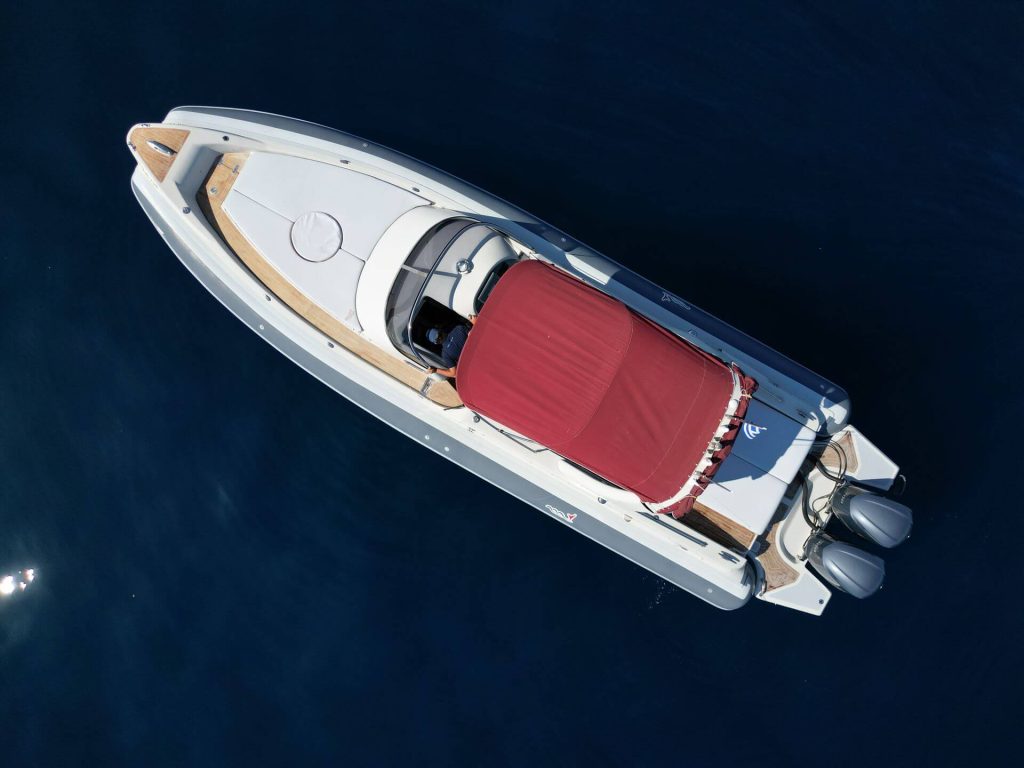
Purpose-Driven RIBs: From Utility to Luxury
RIBs are not just one-size-fits-all boats. Over the years, they’ve evolved into a multi-purpose vessel that fits a variety of needs. From simple utility boats to luxury tenders for superyachts, RIBs are designed to meet the demands of every type of boater. Here’s a look at the main categories of purpose-driven RIBs.
Utility RIBs: The Workhorses of the Sea
Utility RIBs are built for work, safety, and practicality. They’re used by coast guards, rescue teams, diving schools, and commercial fishermen. These boats are made to endure tough conditions while being sturdy, stable, and durable.
Key Features:
- Extra-strong hulls for rough seas
- Large, open decks for equipment and cargo
- Simple, low-maintenance design
- Often equipped with safety features like lifebuoys and rescue ladders
These RIBs prioritize functionality over luxury, and they’re often seen as essential support boats in marinas, ports, and construction sites.
Adventure & Recreational RIBs: For Thrill Seekers & Island Hoppers
If you’re after adventure, exploration, and unforgettable experiences, this is your RIB. These RIBs are fun, fast, and flexible, making them perfect for island-hopping tours, day trips, and adrenaline-packed adventures.
Where They Excel:
- Exploring caves and secret coves only accessible by small boats
- Island-hopping tours in Crete and the Greek Islands
- Snorkeling, cliff diving, and swimming stops in remote locations
- Fishing and spearfishing adventures for those seeking a local experience
They’re lightweight, fast, and provide a sense of freedom that’s hard to match. The open-deck design allows for more passenger capacity, easy boarding, and 360° views of the coastline. Adventure RIBs are a top choice for thrill-seekers, groups of friends, and families looking for an active day at sea.

Chase Boats: Luxury Support for Yachts
For large yachts and superyachts, RIBs often play a supporting role as chase boats or tenders. These RIBs are used to transport guests, supplies, and crew to and from the yacht. But don’t be fooled — these chase boats are not “just support” vessels. They’re equipped with luxury features, ensuring passengers travel in style.
Why Yacht Owners Love Them:
- High-speed transport between yacht and shore
- Easily access shallow bays and ports that larger yachts can’t reach
- Comfortable, stylish seating for VIP guests
- High-capacity for transporting luggage, water toys, and provisions
Many luxury RIB brands, like Technohull, Ribco, Skipper, and Scorpion, design these chase boats with luxury finishes, sunbathing areas, and premium seating to match the high-end aesthetic of the yacht itself.

Luxury RIBs: Style, Comfort & Elegance
When adventure meets elegance, you get luxury RIBs. These boats blur the line between a RIB and a mini-yacht. They’re equipped with spacious decks, sunbathing lounges, and even cabins with bathrooms. Luxury RIBs are perfect for travelers who want both style and adventure.
Luxury Features You’ll Love:
- Plush sunbeds and shaded seating areas
- Onboard WC (toilet) and small cabins for privacy
- Spacious storage for luggage and food for island-hopping trips
- Premium sound systems, refrigerators, and showers on board
If you’re planning to charter a RIB for island hopping, these luxury models are a top choice. They provide everything you need for an all-day (or multi-day) adventure in comfort and style. Luxury RIBs are often found in the 12m+ category, with manufacturers like Technohull, Ribco, Rafnar, Anvera, Cobra, and Skipper leading the way.

Rescue & Patrol RIBs: Built for Safety & Speed
Rescue RIBs are made for one purpose: saving lives. Used by coast guards, lifeguard teams, and naval patrols, these boats prioritize speed, safety, and durability. They’re built to withstand rough seas, extreme weather, and challenging rescue operations.
Key Characteristics:
- Highly visible designs (bright orange, yellow, or red)
- Equipped with medical supplies and rescue gear
- Unmatched stability and reliability in rough waters
- Used as rapid-response patrol boats by coast guards and police
These RIBs are used for rescue missions, emergency evacuations, and border patrols. They’re fast, stable, and designed to reach areas that larger rescue boats can’t.
Commercial RIBs: Built for Business
Many businesses use RIBs for commercial operations, including sea transfers, ferrying passengers, and water taxis. Commercial RIBs prioritize capacity, safety, and reliability. Tour operators, diving centers, and water sports companies use them as fast, affordable transport solutions.
Why Businesses Use Commercial RIBs:
- High passenger capacity for group transfers and tours
- Easy to maintain and repair — minimizing downtime
- Fuel-efficient, reducing operating costs for businesses
- Quick boarding and disembarking for passengers
These RIBs are often seen at dive schools, fishing charters, and marine tours, where speed, efficiency, and stability are essential for a smooth customer experience.
Why to Rent a RIB in Crete & the Greek Islands
The Greek Islands and Crete are a paradise of natural beauty, complex coastlines, and crystal-clear waters. This unique morphology is what makes a RIB (Rigid Inflatable Boat) the ultimate choice for exploring them. With thousands of islands, countless hidden beaches, and secluded coves that are hard to reach by land, a RIB gives you access to places that most tourists never see.
Here’s why a RIB is the best choice for navigating the coastlines of Crete and the Greek Islands.
Access Hidden Beaches, Caves & Secret Coves
The Greek coastline is one of the most dramatic and diverse in the world. Crete alone has remote beaches like Menies, Seitan Limania, and Balos, which are difficult to access by car or large boats. RIBs, however, can navigate shallow waters and tight spaces, allowing you to reach these hidden gems with ease.
Why it matters:
- Secluded beaches are only accessible by RIB due to their shallow entry points.
- Sea caves like the ones near Rodopou Peninsula or Chironisia are narrow and require a boat with agility to enter.
- Secluded coves offer privacy, calm waters, and the chance to relax far from tourist crowds.
With a RIB, you can dock on smaller beaches where larger boats can’t enter, giving you a front-row seat to Crete’s natural beauty.
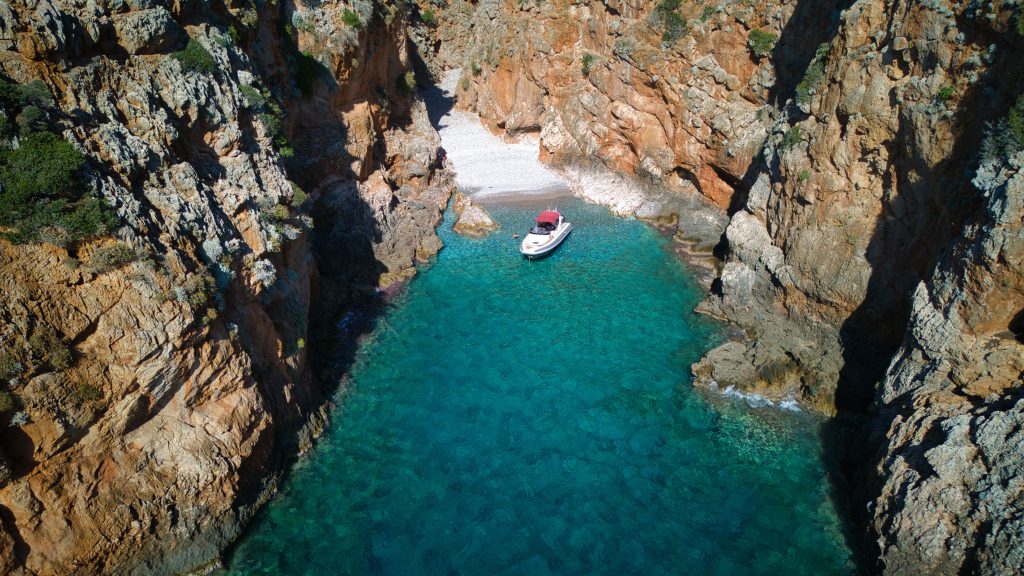
Navigate Long Distances & Open Waters with Ease
The Greek Islands are scattered across the Aegean and Ionian seas, and getting from one island to another often involves long distances. Traditional boats take hours, while ferries follow fixed schedules. A RIB, however, can cut travel time significantly thanks to its speed, smooth ride, and open-water stability.
Why it matters:
- Crete is a large island, and its distances to places like Santorini, Milos, and Dia require a fast, reliable boat.
- RIBs offer speed and smooth cruising, even when the seas are choppy.
- They can handle the famous Greek winds (like the Meltemi) with better stability than most motorboats.
If you’re planning an island-hopping adventure or a transfer from Crete to another island, a RIB is the fastest, smoothest, and safest option.
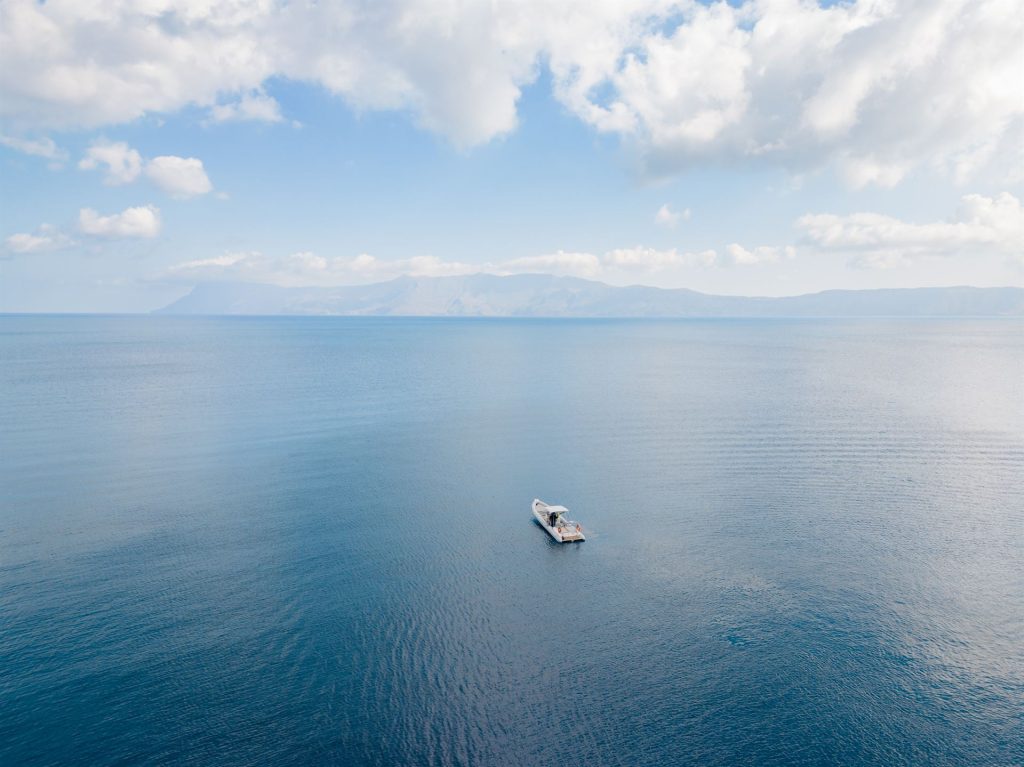
Reach Small Ports & Local Fishing Villages
While ferries and large boats are limited to big ports, a RIB can dock almost anywhere. This opens up a world of authentic Greek experiences in small, off-the-radar fishing villages and local marinas.
Why it matters:
- Small ports like Kolymbari, Marathi, and Loutro are too small for big boats but ideal for RIBs.
- Easy docking means you can stop for a seaside meal at a taverna, explore local villages, and then continue your trip.
- Many of these small ports are entry points for exploring the cultural side of Crete — traditional villages, local food, and authentic Greek hospitality.
Being able to dock in smaller ports gives you the chance to experience Greece like a local, stopping where ferries and larger boats can’t.

Island Hopping Without Limits
Island hopping is one of the most iconic Greek holiday experiences. But instead of following ferry timetables, you can create your own itinerary with a RIB. Want to visit 4 islands in a single day? No problem. With a RIB, you choose where to go and how long to stay.
Why it matters:
- Plan your own schedule — no ferry schedules, no fixed timetables, and no waiting.
- Multiple destinations in one day — unlike day tours, a RIB lets you see several islands and beaches in a single trip.
- Fast transfers between islands — explore from Crete to Dia, Santorini, or Milos.
For island-hopping adventures, no other boat type offers the same speed, flexibility, and efficiency as a RIB.
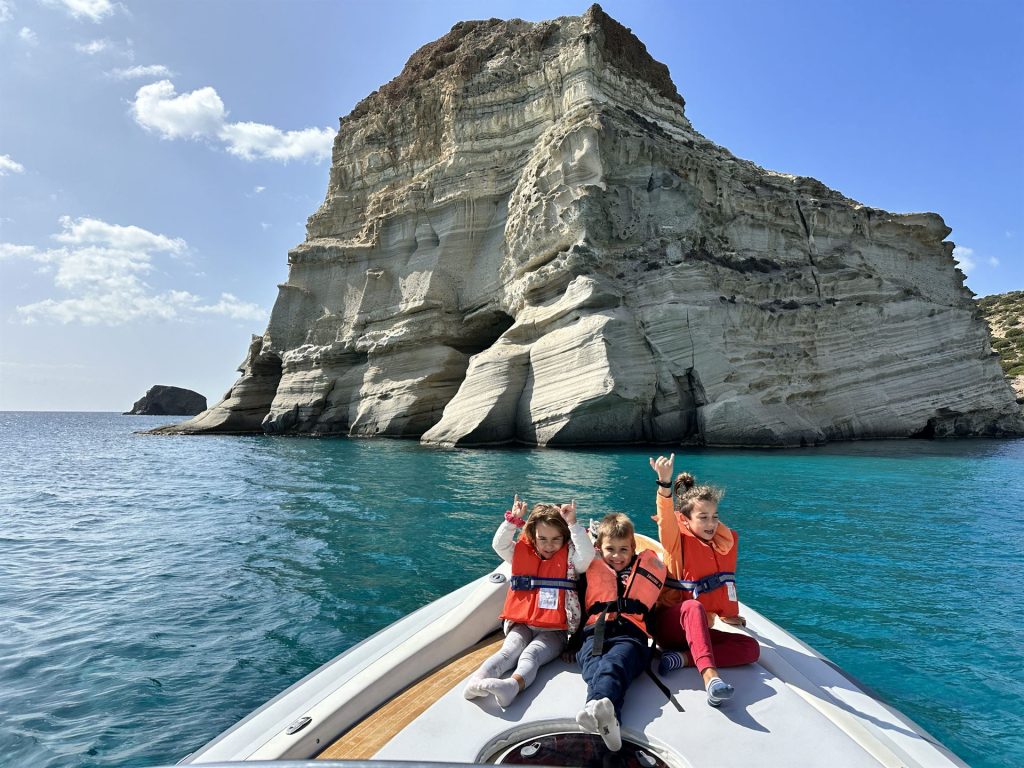
Live the Adventure Like a Local
RIBs are not just for tourists. They’re also the boat of choice for locals in Crete and the Greek Islands. Fishermen, divers, and adventure enthusiasts use them daily for their speed, versatility, and practicality. Renting a RIB means living like a local. Dive into the sea, fish for your own lunch, and explore the coast just like the locals do.
Why it matters:
- Feel like a local, not a tourist, as you navigate small ports, fishing villages, and hidden beaches.
- Spearfishing and fishing trips are more exciting with a RIB, as you can reach secret fishing spots only locals know.
- Experience Greek island life from a local perspective, exploring the coast as fishermen and sailors have done for centuries.
If you want an authentic Greek experience, renting a RIB is your ticket to feeling like a true islander.

Perfect for the Morphology of Crete & the Greek Islands
The unique geography of Crete and the Greek Islands is the main reason why RIBs are the best boat to rent. The islands have jagged coastlines, rocky cliffs, and tiny islets that bigger boats just can’t navigate. Here’s why RIBs are the perfect match for these waters:
- Sharp coastlines & cliffs: RIBs can get close to cliffs and rocky areas for snorkeling, cliff jumping, or photo opportunities.
- Narrow sea caves: With precise control and narrow entry, RIBs can access sea caves like Chironisia and the caves near Balos and Rodopou.
- Remote islets & rocks: Small islets like Gramvousa or Dia are unreachable by large vessels, but RIBs have no problem.
The geography of Crete and the islands is rugged, beautiful, and raw. Only a RIB can truly explore every hidden part of it.

Adventure, Fun & Pure Freedom
RIBs are about freedom, exploration, and adventure. Forget fixed schedules, crowded ferries, and pre-planned tours. When you rent a RIB, you’re in charge. Go where you want, stop when you want, and feel the rush of adventure as you carve through the waves.
Why it matters:
- Pure adventure — explore wild caves, jump off cliffs, snorkel in hidden bays, and live unforgettable moments.
- Full control — it’s your day, your route, and your plan. There’s no “tour guide” telling you when it’s time to leave.
- Adrenaline rush — RIBs are fast, sleek, and fun to drive. It’s like having a high-speed sports car on the water.
Whether you’re on a family trip, a romantic escape, or an adventure with friends, a RIB is the perfect choice for thrill-seekers and explorers alike.
The Best Value for Money in Crete & the Greek Islands
When you rent a RIB, you’re not just renting a boat — you’re gaining access to an unmatched experience. Unlike ferries or traditional day tours, a RIB gives you speed, flexibility, and privacy. You can see more places, save time, and avoid crowded beaches.
Why it matters:
- More destinations in less time — see 5 beaches instead of 1.
- Private experience — avoid crowds, have your own space, and explore in peace.
- Pay for the experience — Instead of spending money on multiple ferry tickets, day tours, and crowded trips, you can have a fully private experience.
If you plan to explore Crete and the Greek Islands, a RIB rental is the best value for your time and money. It’s not just a boat — it’s your key to adventure.
How to Rent a RIB in Crete & the Greek Islands
This section will serve as a practical guide for readers who are ready to take action. It provides clear, actionable steps on how to rent a RIB.
Where Can You Rent a RIB in Crete
You can rent a RIB in key coastal locations across Crete such as:
- Chania Old Port – Perfect starting point for island hopping, extended tours, and exploring the entire Chania region.
- Kissamos – The best starting point for those who want to explore Balos, Gramvousa and the west coast of Crete.
- Kolymvari – A peaceful starting point to explore the hidden beaches and sea caves of Rodopou Peninsula, as well as the iconic Gramvousa and Balos.
- Palaiochora – A prime starting point to explore the famous Elafonisi Beach and the stunning southwest coast of Chania.
- Ierapetra – Perfect for southern coast adventures or trips to the stunning island of Chrissi.
- Heraklion – Rent from Heraklion if you’re staying near Crete’s capital and want to explore the secluded beauty of Dia Island.
- Agios Nikolas – Rent from Agios Nikolaos to explore the scenic Mirabello Bay and visit the historic island of Spinalonga, all in one unforgettable trip.
These starting points give you easy access to remote beaches, sea caves, and famous island-hopping routes.
Where Else Can You Rent a RIB in the Greek Islands
Beyond Crete, you can also rent a RIB in several key locations throughout the Greek Islands. Each island offers a unique opportunity to explore hidden beaches, stunning sea caves, and exclusive island-hopping routes.
Here are some of the most popular island hubs for RIB rentals:
- Santorini – Cruise around the famous caldera, visit the volcanic islands, and explore hidden beaches only accessible by sea.
- Mykonos – Perfect for luxury transfers, day trips to Delos & Rhenia, or exploring secluded beaches away from the crowds.
- Paros & Naxos – Launch from these central Cycladic islands to explore Koufonisia, Antiparos, and other pristine Aegean gems.
- Milos – Explore Milos’s famous sea caves like Kleftiko, and discover the iconic lunar landscape and stunning secluded beaches.
- Rhodes – Discover the beautiful bays of Lindos, Prasonisi, and hidden coastal gems that larger boats can’t access.
- Zakynthos – Famous for the iconic Shipwreck Beach (Navagio), but also offers access to the Blue Caves and secluded beaches.
- Corfu – Explore the stunning Ionian coastline, lush coves, and nearby islands like Paxos and Antipaxos.
- Athens Riviera – Launch from the Athenian Riviera to explore the Saronic Gulf islands (like Hydra, Spetses, and Aegina) or set sail toward the Cyclades.
These islands are ideal for island-hopping tours, transfers, and adventure-filled day trips. Whether you want to visit famous landmarks or escape to secret coves, renting a RIB gives you the freedom to experience it all.
RIB Rentals With or Without a Skipper
You have two rental options:
- With a Skipper: Perfect for those without a license or who want a stress-free experience. Let an experienced local captain guide you to the best spots.
- Bareboat (Without a Skipper): If you have a valid boat license and prior experience, you can rent a RIB on your own. Enjoy total freedom and privacy.
Pro Tip: If it’s your first time renting a RIB, consider hiring a skipper. They know the hidden gems and best places to visit.
What You Need to Know Before Renting
Before renting a RIB, here are some essential points to keep in mind:
- License Requirements: If you plan to rent a bareboat RIB (without a skipper), you’ll need a valid powerboat license.
- Safety Briefing: Before departure, you’ll receive a safety briefing covering essential navigation tips, emergency procedures, and equipment use.
- Fuel Policy: The most common in ribs is to charge per mile in the islands as it is very difficult to refiel the fuel tanks of the boat after your trip – the full to full policy is for small boats usually fix me just this part. For skippered RIB rentals, you’ll know the total price before departure, as prices are usually fixed per route, ensuring transparency and no surprises.
Pro Tip: Ask about the weather forecast, as conditions like the Meltemi winds can affect your trip.
What’s Included in the Rental
When you rent a RIB, you’ll typically receive a well-equipped boat with essentials such as:
- Life Jackets: Safety first! Life vests are provided for all passengers.
- Snorkeling Gear: Masks and snorkels for underwater exploration are often included.
- GPS & Depth/Fish Finder: Essential navigation tools for smooth sailing and fishing adventures.
- Water Toys: Some rentals offer extras like stand-up paddleboards (SUPs) or inflatables.
- Optional Extras: Cooler boxes, drinks, snacks, and beach towels can be provided upon request.
For skippered RIB rentals, the skipper’s fee is typically included in the total price.
Pro Tip:
- Confirm what’s included in the rental price before booking to avoid any surprises.
- Ask for the final price, including VAT and any additional fees.
- If you have special requests (like extra water toys or drinks), make sure to arrange them in advance to ensure availability.
How to Book a RIB
Booking a RIB is easy, and you can reserve your boat in the following ways:
- Online Booking: Use online booking platforms to secure your boat in advance.
- Call or Email: Contact RIB rental providers directly via phone or email for fast responses.
- WhatsApp Contact: Many rental companies offer WhatsApp booking for quick communication.
Pro Tip: Book early during peak season (June-August) to secure the best RIBs and departure times.

